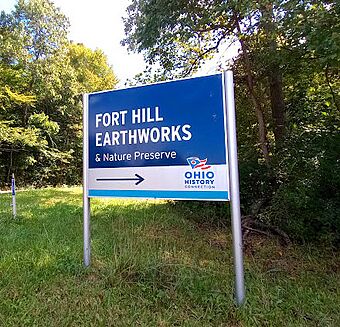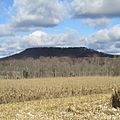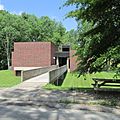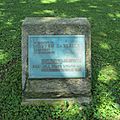Fort Hill State Memorial facts for kids
Quick facts for kids |
|
|
Fort Hill State Park
|
|

Entrance sign on SR41
|
|
| Nearest city | Sinking Spring, Ohio, USA |
|---|---|
| Area | 400 acres (160 ha) |
| NRHP reference No. | 70000500 |
| Added to NRHP | November 10, 1970 |
Fort Hill State Memorial is a special place in Highland County, Ohio, USA. It features an ancient Native American earthwork. This amazing structure was built by the Hopewell culture about 2,000 years ago. Today, the Arc of Appalachia Preserve System and the Ohio History Connection help take care of it.
The earthwork is like a giant walled area made of soil. It sits on top of a flat hill, much higher than the land around it. It is about 500 feet higher than Ohio Brush Creek and 800 feet higher than the Ohio River. The Hopewell people carefully built this wall, which stretches over 1.5 miles around. It encloses an area of about 35.3 acres.
The wall itself is quite impressive, standing between 6 and 15 feet high. It is also about 30 feet wide at its base in most places. There are 39 openings in the wall. Most of these were made by the Hopewell people. Experts believe this site was not used as a fort, but rather as an important religious place.
Contents
Discovering Fort Hill's Past
Early Explorations
In 1846, two early Archaeologists, Ephraim George Squier and Edwin Hamilton Davis, explored Fort Hill. They dug into the earthwork to learn more about its builders. Their findings were shared in a famous book called Ancient Monuments of the Mississippi Valley. This book was published in 1848 and helped people understand these ancient sites.
Nature's Wonders at Fort Hill
Geological Features
Fort Hill State Memorial is not just about ancient history; it also has amazing natural features. You can see different types of rocks, like Silurian, Devonian, and Mississippian sedimentary bedrock. These rocks tell a story of Earth's past. The site also has a cool natural bridge, which is a rock formation shaped like a bridge.
A National Natural Landmark
The area is also a great example of how glaciers changed rivers long ago. Because of its unique natural beauty and scientific importance, Fort Hill was named a National Natural Landmark in 1974. This means it's a very special place for nature lovers and scientists alike.
Images for kids
See also
External links
- Official website from Arc of Appalachia Preserve System: https://www.arcofappalachia.org/fort-hill/
- Fort Hill Earthworks & Nature Preserve - Ohio History Connection







